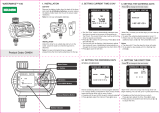
16
Complaint Problem Cause Solution
Water leaking
from relief
valve.
A. Dirt lodged under
seat of valve.
1. Pressure has exceeded
rating on relief valve and
caused valve to open
1. Call your Culligan dealer
for service.
B. Faulty or defective
relief valve
1. Call your Culligan dealer
for service.
Water is
effervescent
A. This can be
expected when water
is aerated under
pressure.
1. Water supply has been
naturally aerated under well
system pressure. As water is
released to the atmosphere,
air molecules separate from
the water molecules.
1. This natural phenomenon
will typically dissipate to the
atmosphere in a matter of
seconds. If preferred, water
can be drawn and stored
in an open container prior
to use (i.e. fill a pitcher and
store in the refrigerator for
cool, fresh drinking water).
Loss of pressure A. See complaint #1, problem A & B
Air spurting at
outside or non-
filtered water
fixtures.
A. Inlet check valve
not sealing.
1. Improper installation
location.
1. Call your Culligan dealer
for service.
2. Foreign material preventing
check valve.
2. Call your Culligan dealer
for service.
3. Worn or faulty check valve. 3. Call your Culligan dealer
for service.
Air spurting
from filtered
water fixtures.
A. Reduced pressure
in distribution system.
1. Service flow demand is
greater than water supply
available from well pump
system.
1. Repair or replace well
pump system.
2. Water flow is restricted by
supply piping and/or water
treatment equipment.
2. Call your Culligan dealer
for service.
Loss of media
through drain
line.
A. New filter
backwashed during
first 24 hours after
installation.
1. New filter media is
shipped in a dry condition
and must soak for 24 hours to
become fully saturated before
a backwash cycle.
1. Clean drain line flow
control, control valve body,
seals, spacers and piston
assemblies
B. Air passing
through filter during
backwash.
1. Excess air accumulated in
aeration tank from aeration
pump.
1. Call your Culligan dealer
for service.
2. Excess air accumulated in
filter system from water supply
or well pump.
2a. Repair well pump
system.
2b. If the cause was due
to temporary loss of water
main pressure; the problem
will most likely correct itself
with the return of continuous
pressure.
Excessive
noise during
regeneration.
A. Howling or
whistling noise
during regeneration
cycle.
1. Inadequate drain line size. 1. Call your Culligan dealer
for service.
2. Drain line is vibrating
against other pipes, conduits,
pipe hangers, heat ducts,
floor joists,etc.
2. Call your Culligan dealer
for service.
Troubleshooting
Guide (cont.)





















